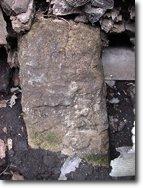| Turkish
Pasha Monument (ca. 1673)
One of the more obscure monuments in Tovste
commemorates the death of a Turkish Pasha, who is thought
to have died in battle around 1673.
The small stone monument is said to refer to a chieftain
killed during an uprising that started near Jagielnica
(about 10 km away) and moved to Tluste. It is thought
that he died and was buried near a narrow road that once
passed through the area, presently occupied by houses.
|
|
 |
By way of historical background the Turks and their allies,
the Cossacks and Tartars, had invaded the Polish territory
of Podolia in 1671, and had achieved widespread military success.
Poland was compelled to sign the so-called Treaty of Buczacz
in October 1672, under the terms of which Podolia and the
southern part of Ukraine became part of the Turkish Empire.
Over the next eleven years of Turkish control, new administrative
divisions were introduced and saw Tluste fall under the supervision
of Chortkiv.
The monument to the Pasha is located next to a shed belonging
to a private dwelling on Shkilna Str. Partially buried and
hidden under a woodpile, it is only about 20-25 cm wide and
about 50-70 cm high. In the 1970s or 1980s, an archaeologist
from Ternopil confirmed that the inscription – which,
today, one can barely discern – was consistent with
‘Arabic’ (sic) script. No one is sure whether
or not the grave may have been looted over the centuries.
Interestingly, the townspeople of Tovste have always known
about the monument, considering it to be a ‘magic stone’
that will bring harm if it is touched. Care was taken to avoid
it when ploughing the fields. The current occupants of the
house were the last to move onto Shkilna Str. in the early
1960s, taking possession of the one remaining vacant lot on
the street. While their house and shed were being constructed,
the builder wanted to move the stone, but the owner objected
and it was left in place. A proposal to relocate the stone
to the museum around the 1980s was similarly rejected by the
neighbours, saying that to move it would bring bad consequences.
Sources:
Dmytrenko, H. pers. comm., 2005.
Kowalski, S. “Jazlowiec: The Town Lost in History”.
Chapter VI. https://www.aerobiologicalengineering.com/wxk116/sjk/jazlow.html.
Pawlyk, J. History of Tovste. Chortkiv, 2000.
p. 33, and pers. comm. 
|

